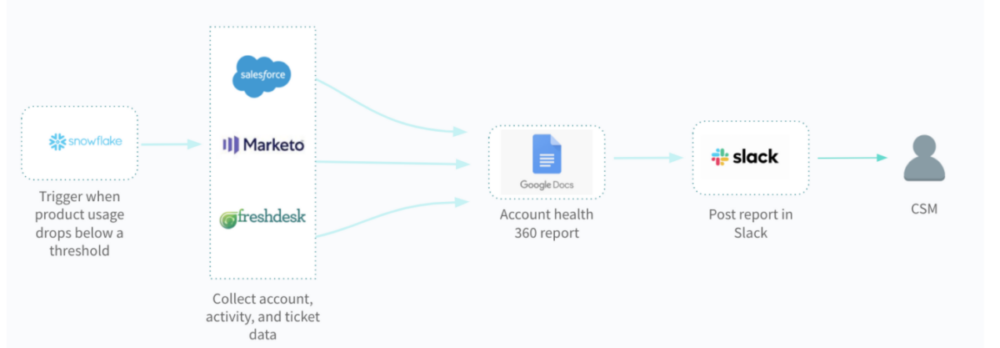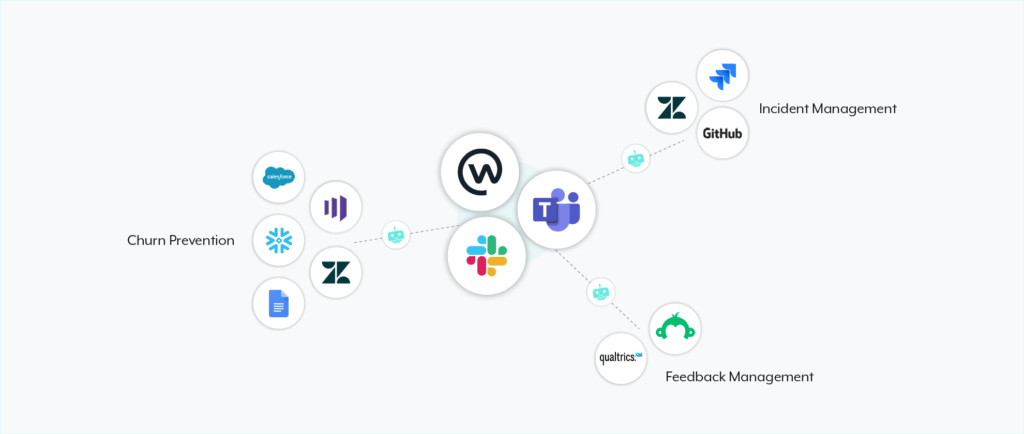The quality of your customer support can make or break your organization’s growth trajectory.
According to a study by Microsoft, 96% of customers consider the quality of customer support they receive when deciding whether to be loyal to a brand. This decision, in and of itself, can have a huge influence on your bottom line. For example, based on research by Bain & Co., simply improving customer retention by 5% can lift your profits by more than 25%.
So how do you ensure that your customer support and customer success (CS) teams are operating at their full potential? By implementing support automation.
Using this type of automation, your customer-facing employees can more easily track issues, resolve any quickly, and manage customer relationships intelligently. We’ll show you how, as well as cover the benefits support automation provides, but let’s start by aligning on its definition.
Related: The ultimate guide to IT automation
What is support automation?
Support automation, or customer support automation, is the use of automation to streamline your support-related workflows end-to-end. These automations can be geared towards improving the customer experience or the employee experience.
Previously, its definition involved a software that could automate specific customer support tasks. Though there’s little question that this type of software can help support reps, our new definition fundamentally transforms how customer support and CS teams operate and how customers and employees benefit.
Examples of customer support automation
To help bring this definition to life, we’ll cover 5 specific ways to implement support automation:
1. Adopt an automated incident management process
As your organization grows, incidents of all shapes and sizes will creep up. Employees may have trouble accessing specific apps; you might uncover bugs in your software; equipment can go missing.
Whatever the issue is, you and your team can work through it quickly and effectively by adopting an automated incident management process.
You would simply use an enterprise chatbot that could communicate between your ticket management system (e.g. Zendesk) and your business communications platform (e.g. Slack). This chatbot would allow you to file a ticket directly in the communications platform and work on it there—up until the issue is resolved (where you can close the ticket in the business communications platform).
Here’s an example of an automated incident management process where someone not only creates a ticket in Slack but also escalates it.
Popular Zendesk integrations
2. Leverage product usage data to detect customers at risk of churn
Understanding how customers are using your product over various points in time can help you better understand the extent to which a customer is seeing value from your organization. This type of insight can help your support team better determine which customers they reach out to, and when they should reach them.
Whatever type of product usage data makes sense to track at your organization, you can build an end-to-end automation that’s triggered once that data falls at, or below, a certain predefined level. Your reps can then be made aware of this insight in real-time, allowing them to take action quickly.
Here’s how it can work:

1. Once a data warehouse (e.g. Snowflake) detects the customer’s product usage falling to a certain level, the workflow gets triggered.
2. The customer’s activity data that lives in various platforms, such as a CRM like Salesforce and a marketing automation platform like Marketo, gets collected and put into a health report in a Google Doc.
3. An enterprise chatbot shares the health report with the appropriate customer support manager via your organization’s business communications platform.
Related: 5 customer support automation statistics you should know about in 2022
3. Automate the process of addressing customer feedback
If you use surveys to track customer sentiment, you can easily keep tabs on the responses and react to any respondent quickly by using support automation.
Here’s how it can work:
1. You collect survey responses using a platform like SurveyMonkey.
2. As the responses come in, they get shared in a specific channel within your business communications platform where your support reps can monitor them.
3. Your reps can track the responses in real time and respond to each accordingly.
Note: You can learn more about this workflow here.
4. Enable employees to get their questions answered with ease
Customers aren’t your only stakeholders that expect a 5-star experience.
Your employees, regardless of their role, want your organization to equip them with the tools, equipment, and insights they need to carry out their day-to-day tasks more effectively.
One step toward meeting these wants is building out a support automation that allows your employees to get their questions answered in mere seconds.
1. An employee accesses a chatbot within their business communications platform, and clicks “Search Zendesk Article”.
2. A modal pops up, where the employee can enter the keyword(s) of the topic they’re interested in along with the Zendesk category it falls under.
3. The chatbot then uses the inputs to comb through the Zendesk knowledge base and identify articles that can help the employee (it does this in real time).
4. The employee then sees these Zendesk knowledge articles appear in the modal, and they can click on any they’d like to read or post it to a channel with the click of a button.
Related: 3 ways to automate your service desk
5. Provide employees with the equipment they need to be successful
Your employees’ equipment-related needs are also likely to evolve over time.
You can ensure that employees’ needs get met quickly and easily by empowering them to make the requests in a platform they’re already working on (i.e. your business communications platform).
1. An employee accesses a chatbot within their business communications platform, and clicks “Equipment Provisioning”.
2. A ticket gets created in a tool like ServiceNow, and, within the business comms platform, the employee can begin adding to the ticket by selecting the equipment they need.
3. The approver then receives a message within the business comms platform that notifies them of the request, allows them to review the ticket in ServiceNow via its link, and enables them to approve or reject the request with the click of a button.
Benefits of customer support automation
Here are just some of the benefits you can expect after applying these customer support automations.
- You’ll provide better customer experiences. By resolving customer issues faster and addressing any proactively, your customers are not only more likely to enjoy working with your team, but also see greater value from using your product.
- You’ll empower employees in support-related roles to save time. Support automation allows your reps to perform all of their work in one place (your business communications platform). The ability to avoid app-hopping saves them a substantial amount of time, and should allow them to focus on more business-critical work, instead.
- You’ll give employees a complete customer view in a single platform. By integrating your apps and allowing the data to move between them seamlessly, your reps can track all of the customer activity, from their ticket history to their product usage, in a single platform. Like the previous benefit, this prevents reps from moving between apps and it all but ensures that no customer insight gets lost or underutilized.
- You’ll improve employee engagement. Arming employees with the equipment, apps, and insights they need through a high-performing help desk puts employees in a better position to succeed, which, in turn, increases their job satisfaction.
- You’ll improve key business metrics. Whether it’s customer or employee-specific metrics, like retention and customer lifetime value, or broader business KPIs, like revenue growth, you should see improvements across the board.
Related: The benefits of ITSM integration
Support automation tools
Now that you’re bought into automating your support processes, let’s review a few of your implementation options:
1. AI-powered chatbots
This type of chatbot can communicate between your business comms platform and the rest of your apps. This allows your employees to work in their apps and automate their workflows without leaving your business comms platform.
We already saw a few of its applications from our earlier examples, but here’s a comprehensive list of ways it can support employees and customers.
Applications for supporting employees:
- Uncovering answers to all kinds of questions
- Making requests and reviewing/approving any
- Hosting recurring team standups
- Sharing files
- Submitting referrals
Applications for supporting clients:
- Managing the full lifecycle of support tickets
- Analyzing product usage data
- Identifying support reps for specific accounts
- Viewing customer email logs
2. Integration-led automation platform
This type of platform allows you to integrate your apps and automate your workflows across apps, data, and teams. It does this by “listening” to your applications for business events, which, when identified, triggers business outcomes (or actions) across your apps.
By leveraging this platform, your support reps and customer success managers can access all the insights they need without moving between apps. This saves them time, which they can reallocate towards delivering value for clients. And it allows them to gain a 360 degree view of their clients, which can aid their efforts in supporting clients thoughtfully and productively.
Furthermore, by using a webhook to trigger the workflow, an integration-led automation platform can help your team move quickly in supporting clients (as the trigger occurs based on real-time data).
Fortunately, there’s a platform that lets you leverage both of these support automation tools. You can read on to learn more.
Related: 3 task automations tools worth considering
Use Workato to automate your support workflows
Workato, the leader in integration-led automation, lets you integrate your apps and automate your workflows end-to-end. In addition, the platform offers Workbot®, a customizable, enterprise chatbot.
Using Workbot, your reps can work in their apps and automate their workflows without leaving your business comms platform, whether it’s Slack, Microsoft Teams, or Facebook Workplace. All the while, Workbot allows your employees to ask questions and make requests as necessary within these apps.
To learn more about how Workato can transform your support processes, you can connect with one of our automation experts.
